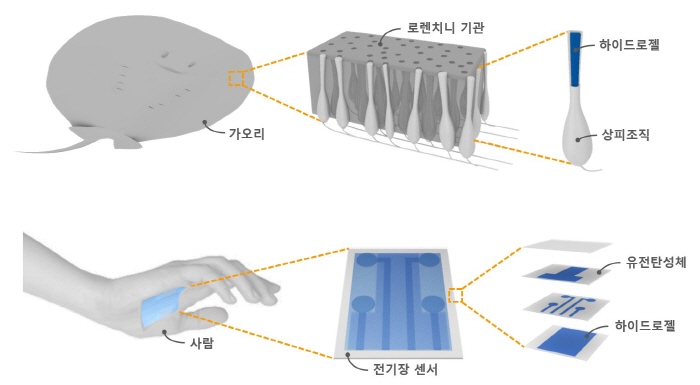loaction
공대뉴스광장
The Joint Research Team of SNU College of Engineering's Department of Materials Science & Engineering and Department of Mechanical Engineering Develop Technology to Remotely Detect Objects Even With Closed Eyes
-
작성자
관리자
-
등록일
2021.12.06
-
조회수
130
The Joint Research Team of SNU College of Engineering's Department of Materials Science & Engineering and Department of Mechanical Engineering Develop Technology to Remotely Detect Objects Even With Closed Eyes
- Research paper published in the world-renowned journal 'Science Advances'
- Remote sensing of the position and movement of nearby objects by mimicking the electric field sensing ability of stingrays
- Remote sensing of the position and movement of nearby objects by mimicking the electric field sensing ability of stingrays

▲ (From left) Professor Jeong-Yun Sun and Professor Ho-Young Kim of Seoul National University
Seoul National University's College of Engineering (Dean Byoungho Lee) announced on November 25 (Thursday) that a joint research team led by Professor Jeong-Yun Sun of the Department of Materials Science & Engineering (Researcher Dr. Younghoon Lee, Ph.D candidate Won-Jun Song) and Professor Ho-Young Kim of the Department of Mechanical Engineering (Researcher Dr. Yeonsu Jung) developed an electric field sensor that can remotely detect the location and movement of nearby objects by mimicking the electric field sensing ability of stingrays
If you look closely at the stingray's skin, you can observe that there are countless small holes filled with transparent jelly. These openings, called the Ampullae of Lorenzini, allow the stingrays to detect changes in the electric field in the surrounding space. Moreover, by leveraging its electric field sensing capabilities, stingrays can remotely sense the position and movement of surrounding prey, even in situations where vision cannot be relied upon.
On the other hand, when a human being is in a situation where he or she cannot rely on sight, the individual has great difficulty detecting the location of objects around them. Humans mainly rely on tactile senses to detect objects in situations where vision is limited, but the use of tactile senses has the disadvantage of limited range and high possibility of contact with unwanted objects.
If so, what would it be like for humans to have the stingray's ability to sense electric fields?

▲ An electric field sensor that simulates a stingray's ability to detect electric fields
Even in situations where vision cannot be relied upon, if it is possible to remotely detect surrounding objects like the way in which stingrays remotely detect food using electric fields, people will also be able to move around more safely in situations where vision is limited. Such technology that can implement such ideas of the imagination was developed by this joint research team. The joint research team developed a sensor that can detect minute electric field changes in surrounding space using electrostatic induction, and optimized performance by identifying the operating principles of the sensor through theoretical analysis and computer simulation. When using an electric field sensor developed by the joint research team, humans can also remotely detect the location and movement of surrounding objects using the electric field, just like stingrays do.
This is not the only surprising factor about the electric field sensor developed by the joint research team. Using the characteristics of an electric field that can pass through an insulator, the research team succeeded in detecting the movement of a person moving behind a wall in real time with an electric field sensor. These characteristics show that the electric field sensor has the potential to be used for lifesaving aid practices at disaster sites in the future.
In addition, the joint research team succeeded in manufacturing skin-attached electric field sensors using 3D printers so that more people can use the technology in their daily lives. If the manufactured sensor is worn, the wearer can receive the location of surrounding objects by sound, and it is thus expected that the wearer will be able to work safely even in situations where one cannot rely on sight.
“We have developed an electric field sensor that can detect the position and movement of surrounding objects by simulating the ability of a stingray to detect an electric field. Using the electric field sensor will contribute in people being able to safely detect the location of nearby objects in situation where one cannot rely on sight," said Professor Jeong-Yun Sun, the research director of this study.

▲ Working mechanism behind the electric field sensor
The electric field sensor developed by the joint research team can detect minute changes in electric fields in the surrounding space by using electrostatic induction. The research team optimized the performance by identifying the operating principle of the sensor through theoretical analysis and computer simulation.

▲Detecting objects remotely using a skin-attached electric field sensor
By wearing a skin-attached electric field sensor manufactured using a 3D printer, the movement of surrounding objects can be transmitted through sound. The manufactured electric field sensor can detect both dynamic and static objects.
Meanwhile, the results of this research will be published on November 26 in Science Advances, a world-renowned international academic journal.
담당부서기획협력실
전화번호880-9148